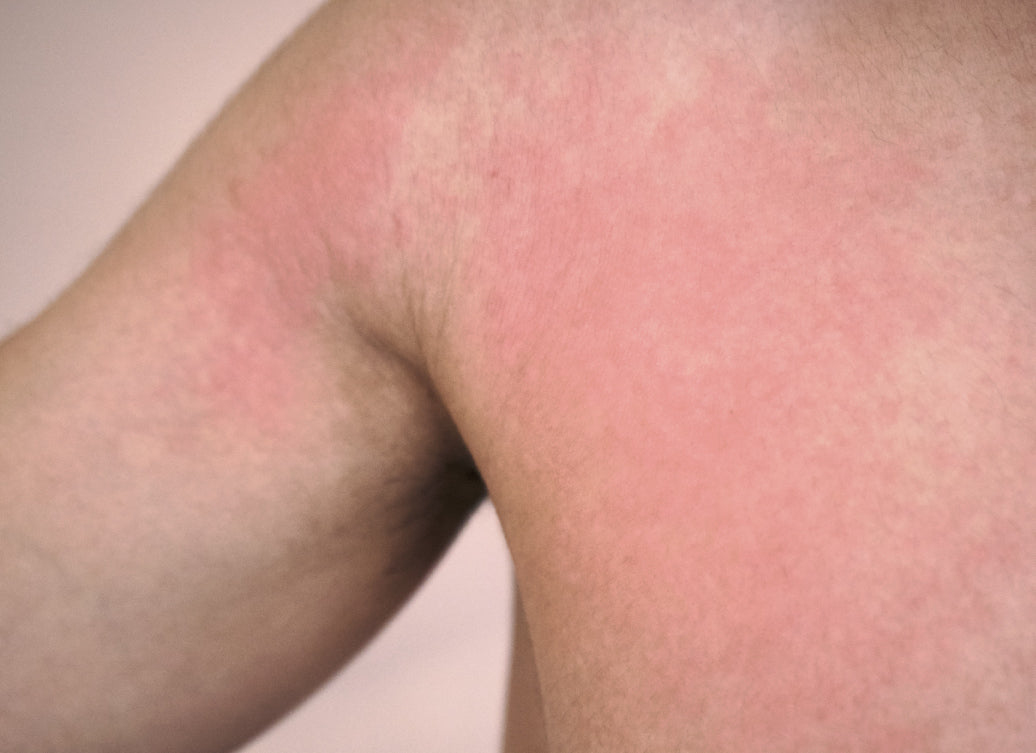Polymorphic light eruption happens when the skin reacts to sunlight; it can be intensely itchy and uncomfortable, but can antihistamines help soothe the rash? Let’s take a closer look.
What is polymorphic light eruption?
Polymorphic light eruption (or PMLE for short) is a slightly mysterious rash that occurs on skin that’s been newly exposed to sunlight. Quite what makes the skin react to the UV light is not fully understood, but the result is that arms, legs or the upper chest area that have been covered in clothes all winter can break out in a rash on the first sunny day of the year!
What does PMLE look like?
PMLE can take a variety of appearances, hence the ‘polymorphic’ (many shapes) part of its name. It can take the form of raised hives; small bumps or spots; dry skin as if it were eczema or dermatitis; sore but flat patches of sensitive or inflamed skin. It can be intensely itchy and uncomfortable, and can last for a few hours or a few days.
What can you do to calm PMLE?
A severe, recurring case of PMLE can be incredibly debilitating to sufferers, spoiling sunny holidays or flaring up continuously over the summer. In these cases, it’s worth going to the doctor and seeing what they suggest. One option is to undergo a course of phototherapy, to ‘harden up’ the affected skin during the spring, so that it’s less sensitive come summer. There are also drug treatments available: beta carotene and hydroxychloroquine and topical vitamin D can help the skin resist the problematic UV light.
Luckily, most cases are much milder, and don’t need medical intervention. In fact, most PMLE eases off as the summer progresses, and is just a temporary irritation. However, during the time when skin is flaring up, it can be really quite uncomfortable and most people suffering from the condition will want to find strategies to calm it down.
Antihistamines and PMLE
Antihistamines are a front-line treatment for all kinds of hives, rashes and itchiness and are commonly used to manage symptoms of hayfever, rhinitis and other kinds of allergies. Antihistamines, as the name suggests, inhibit the production of histamine in the body, which is the substance that is released when the body detects damage. When the skin feels under attack it releases histamine from mast cells to protect surrounding tissue:
“The histamine binds to special sites (receptors) on other cells, called H1 receptors. This sets off a chain reaction which causes blood vessels in the area to become slightly leaky. Specialised cells and chemicals, which defend your body, can now get access to the area. While this is a helpful response, it also causes redness, swelling and itching.” (PatientInfo.Com)
PMLE is a dysfunction of the skin’s reaction to UV light; the body acts as if it were in danger and releases histamine. As it’s a disproportionate response to sunshine, repressing the release of histamine caused by PLME is a good idea, and should lessen the inflammation and itchiness that makes the condition so uncomfortable.
Which antihistamine you take for PMLE is up to you! Some are likely to make you sleepy; others work better for some people than others. Consult your pharmacist and be prepared to try a few before you find one that is effective for you.
For a more comprehensive look at soothing PLME, see our blog How Is Polymorphic Light Eruption Treated?
You might find Balmonds emollients useful to help keep your itchy skin in good, healthy, resilient condition. Although creams and balms cannot ‘cure’ or treat the root cause of PMLE (or other chronic skin conditions), they are effective at providing hydration, locking in moisture, smoothing thickened areas, and keeping skin soft and supple.
Our products do not contain sunscreens! Do not apply oils or oil-based balms like Skin Salvation to exposed areas of skin in bright sunlight, as the oils can make the skin more likely to burn.
Recommended products:
Balmonds Cooling Cream
with shea, menthol, aloe vera & lavender
